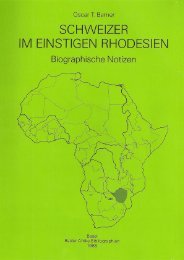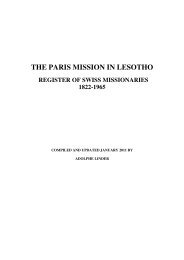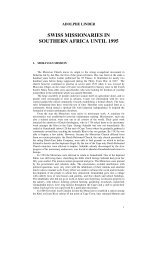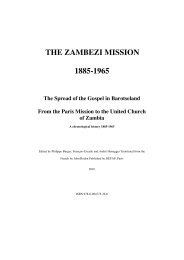THE SWISS IN SOUTHERN AFRICA 1652-1970 - swissroots-za.ch
THE SWISS IN SOUTHERN AFRICA 1652-1970 - swissroots-za.ch
THE SWISS IN SOUTHERN AFRICA 1652-1970 - swissroots-za.ch
You also want an ePaper? Increase the reach of your titles
YUMPU automatically turns print PDFs into web optimized ePapers that Google loves.
Revel’s assistant, a local woman who had done her goodhearted best, assisted by her<br />
husband the hangman. Revel was very ill as a result of his bout of intemperance and<br />
from that time onward foreswore temptation and the acquaintance of his temptor, whom<br />
he described as le vilain cuisinier du General Dundas (a very second rate cook who had<br />
brought the wine – possibly with evil intent born of envy?). From then on he is reported<br />
as cooking to perfection; calamity never again occurred at the hands of the penitent<br />
Revel.<br />
/ Fairbridge: Lady Anne Barnard at the Cape,<br />
Gritz, Francois origin, place and date of birth not known. According to Swiss Family<br />
Name Book might originate from Canton Fribourg. Recorded 7.11.1797 as passenger on<br />
a home-bound ship temporarily in Cape Town. / KAB, BO 195-6.<br />
Staufer, Albert, Swiss?, place and date of birth not known. 1800 resident at 18 Boom<br />
Street. / Cape Almanac 1800.<br />
Orffer, Christiaan born Bönigen near Interlaken BE 28.1.1773, son of Ulri<strong>ch</strong> Urfer<br />
and Maria born Seiler, died 23.9.1831 at Paardeberg near Malmesbury.<br />
Christiaan arrived from England on the English ship Ladoiska on 2.6.1800, during the<br />
first British occupation, and found work as a carpenter. 1 1811-1813 Town carpenter 2<br />
and 1812-1816 first firewarden then inspector of fire engines. 3<br />
Eventually he lived in Leeuwe Street where he had a workshop and like a true Swiss<br />
kept a cow. 4 This single cow did not however satisfy his farming instincts. In 1814 he<br />
applied to the government for a grant of land. 5 This was unsuccessful but around 1817<br />
he nevertheless moved out into the country in sear<strong>ch</strong> of a place where he might live his<br />
life to the full. At Paardeberg north of Paarl he met a lovely girl , Susanna Hendrina van<br />
Dyk, baptised at Paarl 31.1.1790. When, soon after, he obtained grazing rights on a farm<br />
in the Cold Bokkeveld near the top of Gydo’s Pass, he married her 6 and started a family.<br />
They had two sons and a daughter who were baptised at the Tulbagh <strong>ch</strong>ur<strong>ch</strong>.<br />
Orffer had been farming for about ten years, not very successfully, when he found<br />
himself in financial difficulties. His creditor obtained a Supreme Court judgement<br />
against him and on 28.10.1828 the Deputy Sheriff of Worcester was sent out to auction<br />
all his possessions. At a court case 7 held after certain turbulent happenings at the<br />
auction, the Deputy Sheriff testified that on his arrival at Orffer’s house, Orffer had<br />
confirmed that he could not pay the amount owing in cash, whereupon he being under<br />
necessity to proceed with the auction, requested Orffer to hand over the Certificates of<br />
Registration of all his slaves – whi<strong>ch</strong> he did except that of the female slave Spasie,<br />
whom he would not allow to be sold, claiming she was free-born.<br />
The Deputy first sold the oxen and horses, then the few articles of household and<br />
farming implements and finally the slaves. When he called for Spasie to present herself<br />
to the bidders, Orffer ordered her away into the bushes on pain of death, supported<br />
112







